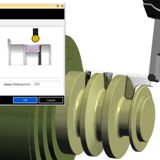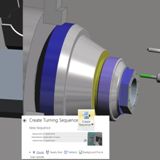Machine Tool Companies To Demonstrate EDGECAM At Southern
Two machine tool companies are highlighting the power of EDGECAM CAD/CAM software, by featuring live machining demonstrations on their stands at the Southern Manufacturing Exhibition.
Romi will show EDGECAM’s high speed Waveform roughing strategy on a D800 machine, and Waveform turning – which is new in EDGECAM 2015 R1 – on a GL-240. Both demonstrations will run on the Romi stand, V122, throughout the exhibition, at Farnborough, between February 10 and 12.
And Matsuura will demonstrate how EDGECAM, from Vero Software, is ideal for 5-axis machining by using it to program a scaled-down version of a helicopter rotorblade cover on their best-selling MX-520 5-axis machine tool (Stand U86).
EDGECAM Strategic Partnership Manager Wesley Tonks says while on-screen demonstrations of EDGECAM will feature on its own stand – T80 – it is difficult to show what it can achieve. “Being able to demonstrate the principals of EDGECAM’s offline programming system on our stand; then the visitors going to see the physical results on the machine tool, will be a major plus.”
Visitors will also be able to see over 50 new and enhanced aspects of functionality in EDGECAM 2015 R1 from Vero Software, which ensure that manufacturers can compete in a global economy:
Rough Waveform Turning: Having developed waveform roughing for milling during the last two years, the new version of EDGECAM also makes it available for turning strategies. The toolpath maintains a constant cutting load, enabling significantly faster cutting data, and prolonging tool life. Similar to other turning commands, the cycle is sensitive to the stock condition, eliminating ‘fresh-air cuts.’
Multiple Setup Support: The new release introduces further Workflow enhancements by supporting multiple setups in both the turning and milling environments. This means both the component and stock and fixtures can be passed to subsequent new, machining sequences. “This enhancement promotes the use of one single CAM file to house multiple machining setups, ensuring the stock remains associative between setups is a massive improvement,” says Wesley Tonks.
Themes – Ribbon Bar Customisation: The default ribbon bar can be customised and saved as a ‘Theme.’ Themes can be exported to other EDGECAM installations and deployed across networks. Users can personalise their individual theme with frequently used commands, even adding custom macros.
EDGECAM Workflow Solids (EWS): Numerous new commands have been added to the internal solid modelling software. DXF and DWG files can now be imported to accelerate the design process. And both internal and external threads can now be created in EWS. An array of time-saving commands have been introduced, such as Copy/Move procedures and the ability to create circular workplanes.
Wire EDM: The Wire EDM product is now available in the Workflow environment, and EDGECAM 2015 R1 offers full machine simulation, including stock and cross-section display.
Turning on Milling Machines: A new machine tool configuration has been introduced, making it possible to turn on a milling machining centre. As well as accurate code output, full machine tool graphics are available for toolpath simulation.
Picking 3D Faces: The Parallel Lace, Constant Cusp, Rest Finishing and Pencil Mill Cycles have all been enhanced to allow ‘direct picking,’ meaning that individual faces or surfaces can be selected and without the need for creating boundaries the entire model will be protected against. Wesley Tonks says “The reduction in the need to create boundaries is one of our primary drivers in making EDGECAM quicker and easier to use.”
New Engraving Cycle: The new machining command ‘Engraving Cycle, allows complex geometry corners to be shaped, and artwork profiles to be machined. Using direct picking, the cycle works with a variety of entities, and offers four different types of strategies.
Ordering of Profiling and Roughing: An Optimise Path function has been added to both the roughing and profiling cycles, giving greater control over the toolpath. Specifically, users can save on wasted toolpath movements by dictating the order in which regions are machined.













